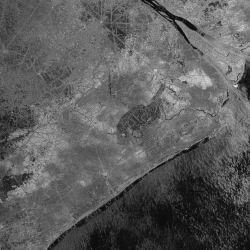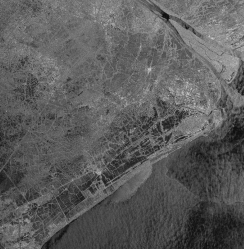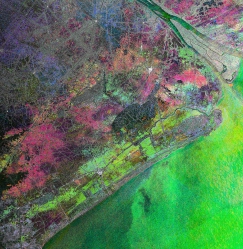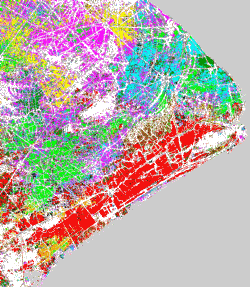The aim of this study is to use
multitemporal synthetic aperture radar (SAR) images in delineating
and mapping areas under different rice cropping systems in the Mekong
river delta, Vietnam. This project is a collaboration between CRISP,
the International Rice Research Institute (IRRI), Philippines and
the University of Can Tho, Vietnam.
Rice cultivation in the Mekong river delta is largely governed by
hydrology, rainfall pattern and the availability of irrigation.
Given the diversity of the cropping systems, it would be very difficult,
if not impossible, to discriminate the areas under different planting
systems using one single-date image. Multi-temporal images are required
to monitor the spatial and temporal growth patterns of the rice
crops and subsequently to identify the cropping systems practiced
at a particular region. Multispectral visible/near infrared images
such as those from the SPOT or LANDSAT satellites could be used
for this purpose. Unfortunately, a large part of the rice growing
season coincides with the rainy period resulting in limited availability
of cloud-free images throughout the growing season. The use of cloud
penetrating SAR would overcome this problem.
Study Area

The study was confined within a 100 km by 100 km area covered by one ERS-2 SAR scene, (track 75, frame 3411 shifted 30% along track) which includes parts of Soc Trang and Bac Lieu provinces in the Mekong river delta, Vietnam.
Multitemporal ERS SAR Images (1996)
Seven descending mode ERS-2 synthetic aperture radar images at 35-day repeat intervals
acquired on May 5, Jun 9, Jul 14, Aug 18, Sep 22, Oct 27 and Dec
1, 1996 were used in the study to delineate and classify rice cropping
systems in the study area.

© ESA 1996 . ERS Image, May 1996 |

© ESA 1996 . ERS Image, June 1996 |

© ESA 1996 . ERS Image, July 1996 |

© ESA 1996 . Color Composite R: may 96, G: June 96, B: July, ERS Image |
The image shown here is a
multitemporal colour composite image derived from three
ERS synthetic aperture radar images of the Mekong River
Delta during the early part of the rice growing seasons
(red: May 5; green: June 9; blue: July 14) in 1996. The
many colours displayed show the different areas under different
rice cropping systems. The areas which appear grey are where
the backscattering coefficient remained relatively constant
throughout the season. These areas correspond to relatively
invariant surface features such as the inland melaleuca
forests, the coastal mangrove forests, the linear settlements,
homestead gardens and orchards along canals and roads; and
the built-up areas.
|
|
Rice Crop Monitoring Using Synthetic Aperture Radar
Rice crops go through distinct growth stages within a given planting season. The growth duration ranges from 3 to 6 months, depending on the variety and the environment. The radar backscatter is strongly correlated with the rice growth stages. Hence, multitemporal SAR is a very appropriate technique for monitoring rice crops.
Rice crop growth stages
 |
In the wet direct seeding method of planting, the rice seeds are sown into flooded fields. Alternatively, the rice seeds may be sown onto dry fields prior to the start of the rainy season (dry direct sedding). In both cases, the fields are inundated while the rice seeds are germinating. |
 |
The vegetative stage is characterised by increase in height and the number of tillers. |
 |
The reproductive stage |
 |
Ripening stage |
Radar Backscattering Signatures

Radar backscattering from rice crops consists of the following components:
- Volume scattering from the canopy: This component increases with increasing biomass.
- Double bounce effect (water - canopy): This component enhances the backscatter from rice plants.
- Direct backscattering from flooded water below the canopy: This component has negligible contribution to the total backscatter.
Generally, the time variation of radar backscatter follows the following sequence during a rice season:
- The beginning of a rice season is characterized by a drop in backscatter, due to the flooded fields.
- During the vegetative phase, the backscatter increases as rice plants grow in height, with increasing biomass.
- The backscatter reaches a maximum value during the reproductive stage, and drops slightly during ripening as the tillers dry up.
- After the crops are harvested, the backscatter depends on the conditions of the fallow soil.
Non-rice vegetation can be identified by their relatively time-invariant backscatter

Typical backscatter time series for single cropped rice

Typical backscatter time series for double cropped rice
Classification of Rice Cropping Systems
A thematic map of rice cropping system was derived using a classification method based on the analysis of the temporal change patterns of the radar backscattering coefficients in the seven SAR images.
 
Classification
|